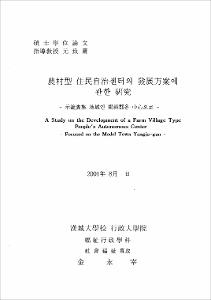농촌형 주민자치센터의 발전방안에 관한 硏究
- Files in This Item:
-
-
Download
 000000066056.pdf
기타 데이터 / 2.75 MB / Adobe PDF
000000066056.pdf
기타 데이터 / 2.75 MB / Adobe PDF
-
Items in Repository are protected by copyright, with all rights reserved, unless otherwise indicated.
 000000066056.pdf
기타 데이터 / 2.75 MB / Adobe PDF
000000066056.pdf
기타 데이터 / 2.75 MB / Adobe PDFItems in Repository are protected by copyright, with all rights reserved, unless otherwise indicated.